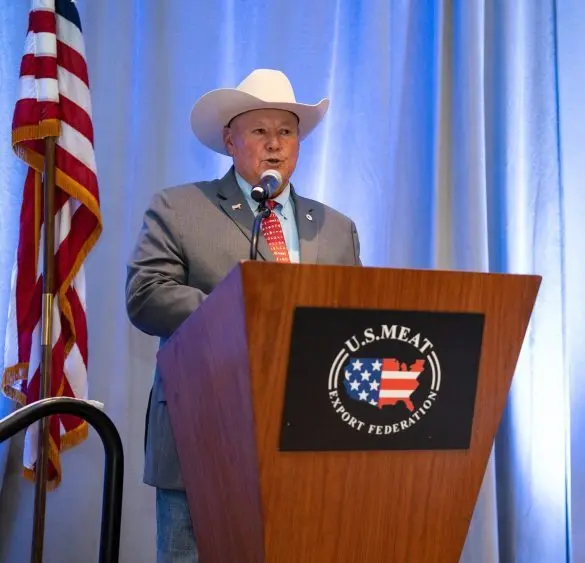Although the U.S. red meat industry faces significant obstacles in the international marketplace, demand remains robust in many key destinations where customers crave the quality and consistency of U.S. pork, beef and lamb. This was the prevailing message delivered by U.S. Meat Export Federation (USMEF) President and CEO Dan Halstrom at the USMEF Strategic Planning Conference, which opened Wednesday in Indianapolis.
Halstrom noted that pork exports are modestly below last year’s record pace, but the gap stems mostly from a period early this year when China’s retaliatory tariffs escalated and the U.S. industry faced uncertainty about plant eligibility. Although export data is only available through July due to the government shutdown, pork shipments are on record pace to leading market Mexico, as well as to Central America and Colombia.
Beef exports have been hit harder by barriers in China, where U.S. beef not only faces retaliatory tariffs, but also unwarranted plant delistings and China’s failure to renew registrations for the vast majority of U.S. beef plants and cold storage facilities. Halstrom emphasized that fully reopening the world’s largest beef import market to U.S. beef will require several actions on China’s part, and the lockout could extend into next year.
“This is obviously a political card that’s being held by the China side,” Halstrom said. “One thing I’m very confident in is that [the Office of the U.S. Trade Representative] is well aware of our position, well aware of what’s involved, and very well-informed. I do think they’ll get it worked out eventually, I just can’t tell you when – no one can.”
While ongoing negotiations with several trading partners may lead to new opportunities for U.S. red meat, especially in Southeast Asia, Halstrom stressed that protecting and defending existing free trade agreements is an urgent priority. He noted that over the past decade, red meat exports to FTA partner countries have expanded by more than 30%, and exports to these destinations now account for 76% of total shipments.
Invoking the Paul Harvey quote, “In times like these, it helps to recall that there have always been times like these,” Halstrom reminded USMEF members that the industry has endured tremendous trade setbacks in the past – citing examples such as widespread market closures due to bovine spongiform encephalopathy (BSE) and plunging consumer confidence and buying power in the wake of the 2008 financial crisis.
“Remember that we overcame all those obstacles,” Halstrom said. “I believe that with the knowledge in this room, and with continued cooperation and collaboration, we can overcome anything.”
Following Halstrom’s remarks, keynote speaker Jan Lambregts, head of RaboResearch Global Economics & Markets, offered a broad overview of the global economic situation and how it has been impacted by various economic policies embraced by the United States, China, the European Union and Russia.
Lambregts delivered insights into recent geopolitical developments and international trade policy through the perspective of a high-stakes poker game. In examining “who holds the cards,” his presentation discussed the macro strategies of the world’s economic and political powers, with a particular emphasis on the complexities of the U.S.-China trade relationship.
“I’m not quite sure if you will like this news, but I don’t think there will be a comprehensive deal coming soon between China and the United States,” Lambregts said. “What the U.S. is demanding is access to Chinese markets. What China will never give is access to the Chinese market because that’s not how they’ve been winning in trade during the past 30-40 years.”
Lambregts says that while the U.S. is currently working to isolate China, both countries are playing for time. China has been cut off from high-end semiconductors, which he called “the lifeline of the 21st century,” and needs time to develop its own semiconductor sector. Similarly, the U.S. needs time to build its rare earths capacity, including development of extraction and processing capabilities.
“In the meantime, the U.S. is basically sending all its allies the same message: What was previously free defense now must be paid for, because we (the U.S.) need to be compensated. And by the way, if you want to trade with China, there are conditions now,” said Lambregts.
Lambregts also addressed U.S. financial support for Argentina, which critics argue could harm U.S. exports, particularly of soybeans and other agricultural products.
“It was a mismanaged move, I would say,” Lambregts explained. “The Trump administration considers (Argentine President Javier) Milei a U.S. ally, and he wanted Milei to do well in the elections. But this deal had a little bit of a hasty feel to it, and now you see unintended consequences.”
The USMEF Strategic Planning Conference continues Thursday with an in-depth look at the upcoming review of the U.S.-Mexico-Canada Agreement, which maintained duty-free access for U.S. red meat in Mexico and Canada, helping to bolster demand in both markets. USMEF will also present its Michael J. Mansfield Award to Ted McKinney, former USDA under secretary for trade and foreign agricultural affairs. Dr. Dermot Hayes, who recently retired as an Iowa State University professor and continues to serve as a consulting economist for the pork industry, will receive the USMEF Distinguished Service Award. More details on these awards and the honorees are available here.
The conference will conclude Friday with a panel discussion on global trade dynamics and potential new opportunities for red meat exports, followed by election of USMEF’s 2025-26 officer team.




